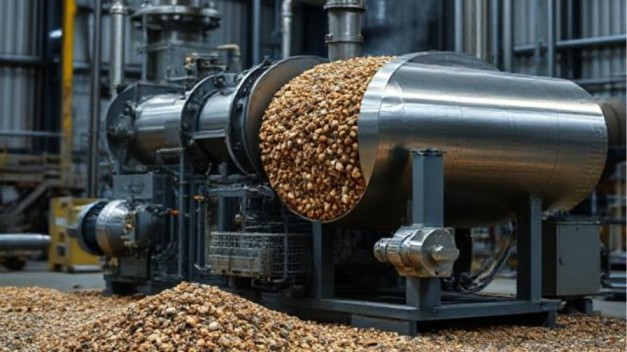Pelletierung, or pelletizing, is a crucial process used in many industries to convert raw materials into small, uniform pellets. These pellets are easier to handle, store, and transport, making them highly efficient in a variety of applications. From agriculture to energy production, pelletizing plays a major role in improving processes, reducing waste, and even contributing to sustainability.
Let’s break down everything you need to know about pelletizing from what it is, to the process, its benefits, and the latest innovations in this field.
What is Pelletierung?
Understanding Pelletizing
Pelletizing is the process of transforming raw materials into small, cylindrical pellets. These pellets are typically uniform in size and shape, making them ideal for various industries. The material is often compressed or molded to create these pellets, which can range from food ingredients to metal scraps.
Types of Materials That Can Be Pelletized
Many types of materials can be pelletized, and here are some of the most common:
- Biomass: Agricultural waste, wood chips, or other organic materials are often pelletized to create biomass pellets for energy production.
- Animal Feed: Grains, proteins, and other nutrients are pelletized to create animal feed that’s easier to store and transport.
- Pharmaceuticals: For uniform drug doses.
- Chemicals and Metals: In industries where precise material size is required for processing.
The Pelletizing Process
Pelletizing involves several steps, from preparing the raw material to packing the final product for distribution. Here’s a breakdown of the process:
1. Material Preparation
Before pelletizing, the raw material has to be prepared. This involves several tasks:
- Grinding: Materials are ground down into smaller particles to ensure uniformity.
- Mixing: Various ingredients may need to be mixed together (especially in feed or pharmaceutical pellets).
- Drying: The material is often dried to the right moisture content to make sure the pellets form correctly.
2. Compression
Once the material is ready, it’s fed into a pellet mill or extruder. Here, the material is compressed under high pressure, forcing it through a die that shapes the material into uniform pellets. This step ensures that the pellets are compact and consistent in size.
3. Cooling and Drying
After the pellets are formed, they are still quite hot and moist. To keep them from deforming or sticking together, they go through a cooling process. The pellets are often air-cooled or pass through a cooling drum. They might also undergo additional drying to ensure the right moisture level for storage and transport.
4. Screening and Packaging
Once cooled and dried, the pellets are passed through a screening process to remove any irregularly shaped or broken pellets. The final product is then packaged and ready for shipping. This ensures that only the highest-quality pellets make it to their intended application.
Benefits of Pelletierung
Pelletizing is more than just a way to shape materials; it comes with several important benefits that improve efficiency, reduce waste, and can even have positive environmental impacts.
1. Improved Handling and Transport
Pellets are easier to handle, store, and transport than bulk materials. Their uniform size and shape make them more convenient to move, whether it’s for animal feed, biomass for energy, or even pharmaceuticals.
2. Enhanced Efficiency
Since the pellets are all the same size and shape, they’re easier to process, whether in manufacturing or as part of an energy system. This uniformity reduces downtime and increases production efficiency.
3. Reduced Waste
Pelletizing helps in reducing waste by making sure materials are compressed into a more usable form. For example, biomass pellets allow for the full utilization of organic materials that might otherwise go to waste, helping reduce overall material loss.
4. Environmental Benefits
Pelletizing can have significant environmental benefits. Biomass pellets, for example, are a renewable energy source that can help replace fossil fuels. By using agricultural waste or other organic materials to make pellets, we reduce the reliance on non-renewable resources and contribute to a greener future.
Applications of Pelletierung
Pelletizing is used across multiple industries. Here are some key areas where pelletization has significant impact:
Agriculture: Animal Feed Pellets
In agriculture, animal feed pellets are a game changer. These pellets provide livestock with a balanced diet, and the process makes the feed easier to transport and store. Pelletizing helps reduce waste and ensures that animals get the right amount of nutrition.
Energy: Biomass Pellets for Renewable Energy
One of the most important applications of pelletizing is in energy production. Biomass pellets are a renewable energy source used in heating and power generation. These pellets are made from agricultural waste, wood chips, or other organic materials and can be burned to produce heat or electricity. Biomass pelletizing is not only efficient but also sustainable, offering a greener alternative to fossil fuels.
Pharmaceuticals: Uniform Drug Doses
In the pharmaceutical industry, pelletizing ensures that drug doses are uniform and precise. By creating small, controlled pellets, pharmaceutical companies can offer patients more consistent and reliable medication. These pellets can also be used in sustained-release drug formulations, allowing for gradual and controlled delivery of the active ingredient.
Chemicals: Industrial Applications
In the chemicals industry, pelletizing is used for creating products like plastics, water treatment chemicals, and other compounds. The uniformity of pellets helps improve processing efficiency, making them easier to work with in large-scale production.
Metals: Foundries and Additive Manufacturing
Metal pellets are also used in foundries, where they can be melted down to create various metal parts. In additive manufacturing (3D printing), metal pellets are often used as a feedstock material, providing precise control over the production of metal objects layer by layer.
Latest Advancements in Pelletierung
As technology evolves, so does pelletizing. Here are some of the most recent advancements making waves in the pelletizing world.
1. Automated Pellet Mills for Precision and Efficiency
Recent developments in automation have brought pellet mills into the future. These machines are now more precise, efficient, and easier to operate. Automated systems ensure that the pellets are of the highest quality and reduce human error, which ultimately lowers costs and increases productivity.
2. Use of Sustainable and Renewable Materials
The trend toward sustainability has led to the use of more renewable materials in pellet production. For instance, agricultural waste, such as straw or sawdust, is increasingly used to create biomass pellets. This reduces the reliance on virgin materials and contributes to a more sustainable supply chain.
3. Development of Advanced Binders and Additives
New binders and additives are improving the strength and durability of pellets. This is especially important for industrial pellets, which need to withstand harsh conditions in manufacturing processes. These advanced materials also help improve the performance of pellets in various applications.
4. Energy-Efficient Pelletizing Equipment
As the world focuses on reducing carbon footprints, pelletizing equipment is becoming more energy-efficient. Modern pellet mills consume less energy, which not only reduces operational costs but also helps decrease the environmental impact of the pelletizing process.
Conclusion
Pelletierung (pelletizing) is a powerful process that plays a vital role in a variety of industries, from agriculture to energy to pharmaceuticals. The ability to take raw materials and turn them into small, uniform pellets makes them easier to handle, store, and transport. Plus, it offers numerous benefits, such as reducing waste, improving efficiency, and contributing to sustainability.
Also Read: Coyyn.com Crypto: Transforming DeFi and the Gig Economy
FAQs about Pelletierung
1. What is pelletierung and why is it important?
Answer: Pelletierung (pelletizing) is the process of converting raw materials into small, uniform pellets. This process is crucial across various industries, from agriculture to energy, as it improves handling, storage, transportation, and efficiency while reducing waste.
2. What materials can be pelletized?
Answer: Materials that can be pelletized include biomass (wood chips, agricultural waste), animal feed, pharmaceuticals, chemicals, and metals. Pelletizing makes these materials easier to transport, store, and process in manufacturing or energy production.
3. What are the main benefits of pelletierung?
Answer: The key benefits of pelletierung include improved handling and transport of materials, enhanced processing efficiency, reduced material waste, and environmental benefits, especially when used for renewable energy production through biomass pellets.
4. How does the pelletizing process work?
Answer: The pelletierung process involves preparing the material (grinding, mixing, and drying), compressing it into uniform pellets using a pellet mill or extruder, cooling and drying the pellets, and then screening and packaging them for storage or transport.
5. What are the latest advancements in pelletierung technology?
Answer: Recent advancements in pelletierung technology include automated pellet mills for better precision, the use of renewable materials like agricultural waste, development of advanced binders for stronger pellets, and energy-efficient equipment that reduces the carbon footprint of the process.



